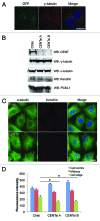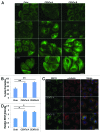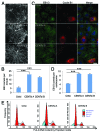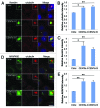Centrobin regulates centrosome function in interphase cells by limiting pericentriolar matrix recruitment
- PMID: 23442802
- PMCID: PMC3637348
- DOI: 10.4161/cc.23879
Centrobin regulates centrosome function in interphase cells by limiting pericentriolar matrix recruitment
Abstract
The amount of pericentriolar matrix at the centrosome is tightly linked to both microtubule nucleation and centriole duplication, although the exact mechanism by which pericentriolar matrix levels are regulated is unclear. Here we show that Centrobin, a centrosomal protein, is involved in regulating these levels. Interphase microtubule arrays in Centrobin-depleted cells are more focused around the centrosome and are less stable than the arrays in control cells. Centrobin-depleted cells initiate microtubule nucleation more rapidly than control cells and exhibit an increase in the number of growing microtubule ends emanating from the centrosome, while the parameters of microtubule plus end dynamics around the centrosome are not significantly altered. Finally, we show that Centrobin depletion results in the increased recruitment of pericentriolar matrix proteins to the centrosome, including γ-tubulin, AKAP450, Kendrin and PCM-1. We propose that Centrobin might regulate microtubule nucleation and organization by controlling the amount of pericentriolar matrix.
Keywords: centriole duplication; centrobin; microtubules; nucleation; pericentriolar matrix.
Figures





Comment in
-
More isn't always better: limiting centrosome size in interphase.Cell Cycle. 2013 May 15;12(10):1482. doi: 10.4161/cc.24853. Epub 2013 Apr 29. Cell Cycle. 2013. PMID: 23652924 Free PMC article. No abstract available.
Similar articles
-
The microtubule nucleation activity of centrobin in both the centrosome and cytoplasm.Cell Cycle. 2015;14(12):1925-31. doi: 10.1080/15384101.2015.1041683. Cell Cycle. 2015. PMID: 26083938 Free PMC article.
-
Nudel contributes to microtubule anchoring at the mother centriole and is involved in both dynein-dependent and -independent centrosomal protein assembly.Mol Biol Cell. 2006 Feb;17(2):680-9. doi: 10.1091/mbc.e05-04-0360. Epub 2005 Nov 16. Mol Biol Cell. 2006. PMID: 16291865 Free PMC article.
-
Centrobin-centrosomal protein 4.1-associated protein (CPAP) interaction promotes CPAP localization to the centrioles during centriole duplication.J Biol Chem. 2014 May 30;289(22):15166-78. doi: 10.1074/jbc.M113.531152. Epub 2014 Apr 3. J Biol Chem. 2014. PMID: 24700465 Free PMC article.
-
Centrosome function: sometimes less is more.Traffic. 2009 May;10(5):472-81. doi: 10.1111/j.1600-0854.2009.00880.x. Epub 2009 Jan 24. Traffic. 2009. PMID: 19192251 Review.
-
Gamma-tubulin complexes and microtubule organization.Curr Opin Cell Biol. 2007 Feb;19(1):24-30. doi: 10.1016/j.ceb.2006.12.008. Epub 2006 Dec 18. Curr Opin Cell Biol. 2007. PMID: 17178454 Review.
Cited by
-
More isn't always better: limiting centrosome size in interphase.Cell Cycle. 2013 May 15;12(10):1482. doi: 10.4161/cc.24853. Epub 2013 Apr 29. Cell Cycle. 2013. PMID: 23652924 Free PMC article. No abstract available.
-
Cep55 overexpression promotes genomic instability and tumorigenesis in mice.Commun Biol. 2020 Oct 21;3(1):593. doi: 10.1038/s42003-020-01304-6. Commun Biol. 2020. PMID: 33087841 Free PMC article.
-
Regulation of microtubule nucleation mediated by γ-tubulin complexes.Protoplasma. 2017 May;254(3):1187-1199. doi: 10.1007/s00709-016-1070-z. Epub 2017 Jan 10. Protoplasma. 2017. PMID: 28074286 Review.
-
CEP55 is a determinant of cell fate during perturbed mitosis in breast cancer.EMBO Mol Med. 2018 Sep;10(9):e8566. doi: 10.15252/emmm.201708566. EMBO Mol Med. 2018. PMID: 30108112 Free PMC article.
-
TACC3 protein regulates microtubule nucleation by affecting γ-tubulin ring complexes.J Biol Chem. 2014 Nov 14;289(46):31719-31735. doi: 10.1074/jbc.M114.575100. Epub 2014 Sep 22. J Biol Chem. 2014. PMID: 25246530 Free PMC article.
References
Publication types
MeSH terms
Substances
LinkOut - more resources
Full Text Sources
Other Literature Sources
Research Materials
